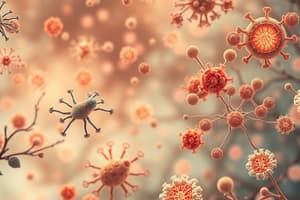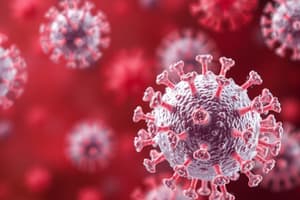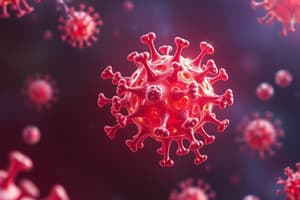Podcast
Questions and Answers
Which characteristic distinguishes idiotypes from other types of antibody variations?
Which characteristic distinguishes idiotypes from other types of antibody variations?
- They are defined by variations in antigen-binding specificity. (correct)
- They are restricted to IgG, IgM, IgA, IgE, and IgD isotypes.
- They are present in all members of a species.
- They involve variations in the constant region of the antibody.
How does the alternative complement pathway differ from the classical pathway in its activation mechanism?
How does the alternative complement pathway differ from the classical pathway in its activation mechanism?
- It requires the presence of Ca²+ and Mg²⁺ ions for activation.
- It is initiated by high molecular weight polysaccharides and lipopolysaccharides on target cell surfaces. (correct)
- It involves the attachment of plasma Mannose-Binding Lectin (MBL) to activate proteins.
- It is activated by the formation of antigen-antibody complexes with IgM.
What is the primary functional consequence of the formation of the membrane attack complex (MAC)?
What is the primary functional consequence of the formation of the membrane attack complex (MAC)?
- Formation of transmembrane pores leading to osmotic lysis and cell death. (correct)
- Opsonization of pathogens to enhance phagocytosis.
- Inhibition of complement activation via regulatory proteins.
- Stimulation of inflammation through peptide fragment split products.
Why do IgG antibodies against the Rh antigen typically fail to efficiently bind and activate the complement system?
Why do IgG antibodies against the Rh antigen typically fail to efficiently bind and activate the complement system?
What is the immediate consequence of C1 binding to two adjacent Ig Fc regions on a target cell?
What is the immediate consequence of C1 binding to two adjacent Ig Fc regions on a target cell?
How does the chemical complexity of an antigen typically influence the immune response it elicits?
How does the chemical complexity of an antigen typically influence the immune response it elicits?
In the context of blood group antibodies, what is the key distinction between naturally occurring and immune antibodies?
In the context of blood group antibodies, what is the key distinction between naturally occurring and immune antibodies?
Why are monoclonal antibodies often preferred over polyclonal antibodies in diagnostic testing?
Why are monoclonal antibodies often preferred over polyclonal antibodies in diagnostic testing?
How does the molecular weight of an antigen influence its immunogenicity, according to the text?
How does the molecular weight of an antigen influence its immunogenicity, according to the text?
What distinguishes alloantibodies from autoantibodies in the context of antigen-antibody reactions?
What distinguishes alloantibodies from autoantibodies in the context of antigen-antibody reactions?
Which of the following mechanisms primarily contributes to the functionality of proteolytic enzymes in immunohematology?
Which of the following mechanisms primarily contributes to the functionality of proteolytic enzymes in immunohematology?
How do DTT (Dithiothreitol) and β-2-mercaptoethanol (2-ME) selectively modify immunoglobulin molecules in immunohematological testing?
How do DTT (Dithiothreitol) and β-2-mercaptoethanol (2-ME) selectively modify immunoglobulin molecules in immunohematological testing?
What is the primary advantage of using monoclonal reagents over polyclonal reagents in blood banking?
What is the primary advantage of using monoclonal reagents over polyclonal reagents in blood banking?
What is the role of AHG (Anti-Human Globulin) reagent in terms of facilitating the detection of RBC sensitization?
What is the role of AHG (Anti-Human Globulin) reagent in terms of facilitating the detection of RBC sensitization?
How does ZZAP, a combination of thiol reagent and proteolytic enzyme, modify red blood cells for immunohematological studies?
How does ZZAP, a combination of thiol reagent and proteolytic enzyme, modify red blood cells for immunohematological studies?
Which characteristic of the acquired immune system is most crucial in preventing autoimmune reactions?
Which characteristic of the acquired immune system is most crucial in preventing autoimmune reactions?
How does the recognition of self and nonself contribute to the function of the immune system?
How does the recognition of self and nonself contribute to the function of the immune system?
How do T helper (TH) cells orchestrate immune responses considering their CD4 marker?
How do T helper (TH) cells orchestrate immune responses considering their CD4 marker?
Given that IgG1 antibodies are most often implicated in severe Hemolytic Disease of the Newborn (HDN), what unique property of IgG antibodies contributes to this condition?
Given that IgG1 antibodies are most often implicated in severe Hemolytic Disease of the Newborn (HDN), what unique property of IgG antibodies contributes to this condition?
Considering the roles of innate and acquired immunity, what advantage does the acquired immune system provide over the innate immune system in responding to a novel pathogen?
Considering the roles of innate and acquired immunity, what advantage does the acquired immune system provide over the innate immune system in responding to a novel pathogen?
Which of the following is not involved in the acquired or adaptive immune response?
Which of the following is not involved in the acquired or adaptive immune response?
Which cells are involved in the production of antibodies?
Which cells are involved in the production of antibodies?
Which of the following cells is involved in antigen recognition following phagocytosis?
Which of the following cells is involved in antigen recognition following phagocytosis?
The role of the macrophage during an antibody response is to:
The role of the macrophage during an antibody response is to:
Which of the following immunoglobulins is produced in the primary immune response?
Which of the following immunoglobulins is produced in the primary immune response?
Which of the following immunoglobulins is produced in the secondary immune response?
Which of the following immunoglobulins is produced in the secondary immune response?
Which of the following MHC classes are found on antigen presenting cells?
Which of the following MHC classes are found on antigen presenting cells?
Which of the following MHC classes encodes complement components?
Which of the following MHC classes encodes complement components?
Which of the following immunoglobulins is most efficient at binding complement?
Which of the following immunoglobulins is most efficient at binding complement?
Which portion of the immunoglobulin molecules contains complement binding sites?
Which portion of the immunoglobulin molecules contains complement binding sites?
Which complement pathway is activated by the formation of antigen-antibody complexes?
Which complement pathway is activated by the formation of antigen-antibody complexes?
Which of the following is known as the “recognition unit” in the classical complement pathway?
Which of the following is known as the “recognition unit” in the classical complement pathway?
Which of the following is known as the “membrane attack complex” in the classical complement pathway?
Which of the following is known as the “membrane attack complex” in the classical complement pathway?
Which of the following immunoglobulin classes is capable of crossing the placenta and causing hemolytic disease of the newborn?
Which of the following immunoglobulin classes is capable of crossing the placenta and causing hemolytic disease of the newborn?
Which of the following refers to the effect of an excess amount of antigen present in a test system?
Which of the following refers to the effect of an excess amount of antigen present in a test system?
Which of the following refers to the presence of an excess amount of antibody present in a test system?
Which of the following refers to the presence of an excess amount of antibody present in a test system?
Which of the following refers to a state of equilibrium in antigen-antibody reactions?
Which of the following refers to a state of equilibrium in antigen-antibody reactions?
Which one of the following properties of antibodies is NOT dependent on the structure of the heavy chain constant region?
Which one of the following properties of antibodies is NOT dependent on the structure of the heavy chain constant region?
Molecules that promote the update of bacteria for phagocytosis are:
Molecules that promote the update of bacteria for phagocytosis are:
Select the term that describes the unique confirmation of the antigen that allows recognition by a corresponding antibody:
Select the term that describes the unique confirmation of the antigen that allows recognition by a corresponding antibody:
Which of the following terms refers to the net negative charge surrounding red blood cells?
Which of the following terms refers to the net negative charge surrounding red blood cells?
Flashcards
Antibody Isotype
Antibody Isotype
Variation present in all members of a species (IgG, IgM, IgA, IgE, IgD).
Antibody Allotype
Antibody Allotype
Variation present in the constant region of antibodies.
Antibody Idiotype
Antibody Idiotype
Variation present in the antigen-binding specificity of antibodies.
Complement System Roles
Complement System Roles
Signup and view all the flashcards
Classical Complement Pathway
Classical Complement Pathway
Signup and view all the flashcards
Antigen
Antigen
Signup and view all the flashcards
Polyclonal Antibodies
Polyclonal Antibodies
Signup and view all the flashcards
Monoclonal Antibodies
Monoclonal Antibodies
Signup and view all the flashcards
Naturally Occurring Antibodies
Naturally Occurring Antibodies
Signup and view all the flashcards
Immune Antibodies
Immune Antibodies
Signup and view all the flashcards
Dielectric Constant Enhancers
Dielectric Constant Enhancers
Signup and view all the flashcards
Low Ionic Strength Solution (LISS)
Low Ionic Strength Solution (LISS)
Signup and view all the flashcards
PEG and Polybrene
PEG and Polybrene
Signup and view all the flashcards
Proteolytic Enzymes
Proteolytic Enzymes
Signup and view all the flashcards
AHG Reagent
AHG Reagent
Signup and view all the flashcards
Placental IgG Antibodies
Placental IgG Antibodies
Signup and view all the flashcards
Immune System's Two Major Roles
Immune System's Two Major Roles
Signup and view all the flashcards
Two Major Branches of the Immune System
Two Major Branches of the Immune System
Signup and view all the flashcards
Two Major Arms of the Acquired Immune System
Two Major Arms of the Acquired Immune System
Signup and view all the flashcards
T Cell Subpopulations
T Cell Subpopulations
Signup and view all the flashcards
Study Notes
Fundamentals of Immunology for Blood Bankers
- The immune system (IS) has two parts: defense against foreign entities and managing damaged cells
- It responds to damaged red blood cells and diseased cells in the host body
Comparison of Innate and Adaptive Immunity
- Innate immunity represents the primary defense line, naturally present at birth.
- It offers non-specific and immediate protection through physical, biochemical, and mechanical mechanisms
- Adaptive immunity supplements innate defenses and is acquired through contact with specific foreign substances
- It is specific to pathogens
- The initial contact with a foreign substance prompts the synthesis of specialized antibody proteins reactive to foreign bodies
- This creates immunological memory, which allows for improved responses upon subsequent encounters.
Cellular and Humoral Components of the Immune System
- Cellular immunity is mediated by macrophages, T-cells, and dendritic cells
- Lymphokines, cytokines, and chemokines facilitate communication within the cellular system
- Humoral immunity involves fluid-based elements like antibodies and complement components found in plasma, saliva, and other secretions
- Antibodies bind to antigens, forming a complex that inactivates the antigen and triggers mechanisms that destroy the antigen and the bound cell
Innate and Acquired Immunity
- IS prevents infection and damage
- Innate immunity is a simpler primary defense, nonspecific and present from birth
Second Line of Defense
- Cellular immunity involves phagocytic cells, including mononuclear cells, polymorph nuclear cells, and natural killer cells that detect infected or abnormal host cells
- Humoral immunity involves cytokines, which modulate immune responses in terms of specificity, intensity, and duration
- Interferon helps stop the rapid progression of disease by destroying virally infected cells
- Interleukins signal leukocytes to become active and increase their numbers
Complement Alternate Pathway
- The alternate pathway occurs by recognition of polysaccharides and liposaccharides on the surfaces of bacteria and tumor cells
- Acute inflammatory reactions are initiated by tissue damage, leading to increased blood flow, increased vessel permeability, activation of heat-shock proteins, and maintenance of healing
Acquired or Adaptive Immunity
- This depends on innate immunity, developing the ability to adapt and destroy complex pathogens
- The acquired IS employs antibodies with memory for defense against repeat pathogens
Lymphocytes
- T-lymphocytes mature in the thymus and produce cytokines to destroy infected host cells
- B-lymphocytes mature in bone marrow and secrete antibodies when stimulated
- NK cells protect against viruses
- Dendritic cells present in tissues are responsible for antigen presentation
- Macrophages process antigens
Cluster of Differentiation
- Different cells possess markers called the Cluster of Differentiation (CD) for recognition.
- The IS activates host cells recognizing an antigen, multiplying them into a large number of cells
- The cells is called Progenition which divide many times to make clones of genetic copies that all attack the same antigen
- If the antigen is recognized by various cells, they form colonies and produce diverse antibodies
- Memory is acquired when lymphocytes recognize antigens from previous encounters; some remain in circulation for rapid immune response to repeated pathogens
B-Cells
- B-cells produce antibodies either through secretion from plasma cells or by direct contact with pathogens via membrane-bound antibodies
- B-cells can provide lifelong immunity and called Memory B-cells that "have antibody on their surfaces" called Opsonization making the cell lysis
T-Cells
- T-cells recognize antigens of host cells via the Major Histocompatibility Complex (MHC), which are produced by MHC genes
- MHC Class 1 genes code for HLA-A, HLA-B, while MHC Class 2 genes code for HLA-DR, HLA-DQ, and HLA-DC
- T-cells produce "cytokines" via TH1 and TH2 to stimulate B-cells, macrophages, and TC cells on antigen recognition or kill cells
Antigen Presenting Cells (APCs)
- APCs include macrophages, neutrophils, B-cells, and dendritic cells in the skin (Langerhans cells).
- Nervous tissue → glial cells and Lymph nodes, spleen, intestines, liver → “Kupffer cells”, thymus bone → osteoclasts
- Primary lymphoid organs are thymus and bone marrow, which are where cells differentiate and mature
- Secondary lymphoid organs are lymph nodes, spleen, and mucosa where cells interact with antigens
Immune Response Times
- The latency or window period lasts for days to months; the log phase reflects the duration of exposure to an immune response
- Primary antibodies are IgM but secondary responses are IgG, where antibodies are higher in quantity and avidity for antigens after cleared.
Cell Lineage and Markers
- Hematopoietic stem cells are "Pluripotent hematopoietic progenitors or CD34+ cells
- Myeloid Pathway: monocytes to macrophages in tissues and blood – Lymphoid Lineage: T cells (TH1, TH2), B cells, NK cells are included.
- FC receptor and complement receptor (CD16) CR1 are used by phagocytes during opsonization
- PMNs possess FC receptors (CD16) CR1 (CD35).
- Eosinophils are critical in allergic reactions and for inflammation in parasitic infection
- Basophils and mast cells possess high-affinity FC immunoglobulin, releasing histamine during allergic reactions B-cells possess complement receptor CD35 and CD21, FE receptors for IgG, plus CD19, CD20, and CD21 markers
NK Cells
- NK cells, also known as third population possess CD56 and CD16, can lyse infected cells and tumor cells through antibody-dependent cell-mediated cytotoxicity (ADCC) Cytokines some have some function and others opposing function.
- Cytokines regulate immune response with the specificity, intensity and duration
- Interferon destroys infected cells, where Interleukins signal leukocytes to become active
Cytokines
- These are soluble protein or peptide molecules mediating immune responses by lymphocytes or macrophages
- The major classes of cytokines include Interleukins (IL), Interferon (IFN), Tumor necrosis Factor (TNF), and colony stimulating factor (CSF).
- Cytokine act by binding to specific target cell receptors, also called “Chemokines" which are attractant molecules that interact between cells, immunoglobulin and complement protein.
Immune System Genetics
- During lymphocyte development, gene rearrangements form new protein arrangements, enabling B-cells to produce specific antibodies
- Isotype switching requires DNA arrangement to make antibodies react
- RAG-1 and gene RAG-2 regulate genetic recombination and antibodies produced
MHC Markers
- MHC Class I markers are on nucleated cells except for trophoblast and sperm and play a key role in (T Cell) function
- MHC Class II markers are located on APCs (Antigen-presenting cell).
Immune Suppression
- Caused by cytokines, little immunoglobulin, loss of T and B cells, immune stimulation, organ failure, drugs like corticosteroids, diseases like AIDS, genetic lesions causing a decrease in immune responsiveness
- Immunocompromised patients require irradiated blood products for transfusion to defend against donor lymphocyte attacks
Immunoglobulin Characteristics
- Antibodies are known as complex proteins produced by plasma cells
- They bind to antigens neutralizing toxic substances, classified by the structure of their heavy chain for IgG, IgA, IgE, IgD, and IgM.
- The basic Ig structure features two identical light chains and two heavychains linked by covalent disulfide bonds
Immunoglobulins
- The heavy chains are linked by disulfide linkages in the hinge region
- The enzyme papain splits the antibody at the hinge region, with the Fc section responsible for complex fixation
- Fab portions attach to antigens to the molecule
- IgG, IgM, IgA signify important blood banking antibodies where IgG reacts best at 37°C
ABO Antibodies
- IgM antibodies, ABO respond to intestinal flora, pollen, Lewis, I; P and MNS-Produce IgM which react best at (22-24°C)
- IgM is exists in both monomeric and polymeric form as (pentamers) containing a J “joining chain, B-2“
- IgG antibodies are effective with causing HDN which reacts with mercaptoethanol (2-ME) or dithiothreitol (DTT) that can cleavage covalent bonds sulfhydryl
IgG Variants
- Classes have different constant regions and disulfide bonds where HDN is associated with IgG antibodies that are capable of crossing the placenta from mother to infant
IgM, IgA, IgE, IgD
- IgA and IgM exist as monomers and polymers
- IgA is found mucosally
- Anti-IgA can trigger anaphylaxis.
IgE
- This important monomeric in allergic reactions, its FC portion attaches to mast cells and facilitate histamine release
IgD
- This primarily matures B cells and antibody production that are bound membrane.
Ig Variants
- Isotype, Allotype, Idiotype are variants that have Antibody inherited variations
Ig FC Receptors
- B-cells, and neutrophils have receptors to IgG₁ and IgG3 bind at CH3 domain of the Fc
Complement System
- Complement functions include; primary is direct lysis of cell and bacteria, secondary is facilitate phagocytosis
- The components are C1 to C9, factor “B”/D/P, Activation need Ca²+ and Mg2+
- The inhibitors proteins:- C1 inhibitor and Factor H/I (anaphylatoxin inactivator) membrane attack complex (MAC) inhibitor and C3 nephritic Factor act in process
Complement Activation
- Complement is typically activated via classical pathway by antibodies, or alternative pathways by bacteria or Lectin pathways by MBL
Membrane Attack Complex
- Cell membrane death occurs when the transmembrane structures create a pore; antibody-mediated killing occurs through complement binding
- C1 molecules require two adjacent Fc regions; IgG antibodies typically don't bind due to low antigen levels.
- Anti-Lewis IgM can activate complement, though is limited because of its limited optimal reactivity temperature
Antigen Characteristics
- Antigens are anything can form and react with antibodies by initiating an IS response
Molecular Size
- Increasing in size of molecule weight larger than 10,000 Daltons, stimulate the most rigorous IS response
- Less soluble antigens are less elicit an immunes responses.
Polyclonal Vs Monoclonal
- Polyclonal antibodies produce with different epitopes with confusing data, while Monoclonal specific and uniform when produced produce single epitopes
Antibody Classifications
- Natural: Antibodies found naturally occur and are found in individuals who have had no previous exposures to transfusions and pregnancy, commonly called IgM
- Immune: Antibodies only found in individuals that have had previous exposure to blood or those that have had a pregnancy, commonly IgG
- Unexpected: A and B antibodies, all other directed is unexpected
Alloantibodies vs Autoantibodies
- Allo-: Alloantibodies produce from those only exposed to nonself antigens
- Auto-: Autoantibodies produce upon onself, and have detectable specificities, otherwise referred as pan- polyagglutinins
Intermolecular Binding Forces
- Hydrogen/ electrostatic bonds help with the charges with molecules Van der Waal forces appear when molecule is a weak interaction between atoms, while bond that is hydrophobic results in over lap of amino acids called the protein
Antibody Factors
- Affinity, Avidity, and Specificity all interact with the attractive-repulsive force single and multivalent with how relative its antigen is
- Reactions include specific reaction or no reaction when there is similar epitope or not to the epitope
Nutritional Factors (Host)
- Nutritional status with malnutrition decreasing Th cells with lower ability to bind
- Hormones affect binding and can suppress or increase immune responses
Host Factors
- Genetic inheritance of MHC
- Age declines response levels
Potential to Increase Response
- Race, Sex, Physical Activity, Overall health
Tolerance
- This is defined as an inadequate response or inability to achieve immune response
Blood Sample Readings
- Serum, edta, and sodium heparin are used to see viable complex, while plasma is preferred for DAT and elution studies because they lack fibrin
- Complement maintains activity for 48 hours at 4 degrees Celsius, or -50 degrees Celsius when frozen
- At 56°C for 30min, serum is deactivated by heat, or inactivation of factor B occurs at 50°C after 20 min
Traditional Lab Methods
-
Hemagglutination/hemolysis: Detects Ag-Ab reactions directly by the rupturing of the RBCs that is being tested
-
RIA/ELISA (or EIA), IF techniques: These immunologic methods focus on radiolabels by enzyme or antigen-antibody.
Main Effects of Tests:
-
Centrifugation increases gravity and time while Antigen/Antibodies make sure you have all the right reactants with them in order to not cause error
-
You NEED to have an equalivalent/prozone/ and post Zone for things not to get misinterpreted.
-
When pH is between 6.5 and 7.5 and Temperature is 22°C (IgM) 37/C for (IgG) with a saline media from 85%- 90% can show accurate results.
-
Protein and enhancements* increase in order to reduce charge where sodium chloride in a low ionic strength reduce zeta potential (5-15minutes of sensitization and incubation)
Additional factors to be wary of for the tests:
Polythylene can add Glycol and macromolecule additives that help with the reaction/crosslink the antigents when read.
PEG produces reliable reactions and is well for detection.
Enzymes react with condition alteration and change other molecules without being able to be altered with things like " Ficin and Papain"-
AhG determine if cells are coated with antibodies. AHG allows for the link on red bloood cells. DTT reduces with its enzyme and cause the antigens on the surface of antigens.
- Reagents made in polyclonal means there are a lot of changes to happen that causes error (epitopes are increased) by the cell as opposed to
- Monoclonal which gives an exact replica
New lab methods:
- Flow- use Antibodies for antigens and cell sorting.
- Solid: a system used to oppose hemoglobin to see positive vs negatives
- Gel: a type of gel used for identification.
- Affinity AcT* and proteins are added to card for reactions
- "G" proteins for all types of IgG
- A place where AhG
- Protein "A" and IgG
Immunoglobulin disease:
- Autoimmune: antibodies produced from own cells and/or tissue and is from the immune system
- Monocolonal gammopathes will cause aggregatons of aggulitation
- High doeses are given to the mother for fetal cells and Igg levels can move through the mother.
Summarized chapter notes:
- The equilibrium of human is dependent on the immune system.
- Damage is caused by removal and recognition.
- TH, Tc, B are types of cells that have CD molecules -Lymphocytes can determine from self and Non-self -Antibodies attach and react if they correlate.
·Memory exists because they stay stagnant untile second exposures
·Immunoglobins are determined by disuffide.and other types of chains the result in goodimmune
·Epitopes are variable.
Studying That Suits You
Use AI to generate personalized quizzes and flashcards to suit your learning preferences.




